Introduction: Saudi Arabian Cuisine
Saudi Arabian cuisine is a rich and diverse amalgamation of various cultural and historical influences. The cuisine of Saudi Arabia features a fusion of flavors and spices that reflects the country’s long and eventful history. Saudi Arabian cuisine is primarily based on rice, lamb, chicken, vegetables, and spices. The cuisine of Saudi Arabia is known for its use of aromatic spices and herbs, which give it a unique and delicious taste.
Historical Influences on Saudi Arabian Cuisine
Saudi Arabia’s cuisine has been influenced by various historical events and cultures. The Bedouin nomads, who lived in the desert, have had a significant impact on the Saudi Arabian cuisine. The Bedouin cuisine is known for its simplicity and reliance on locally available ingredients. The cuisine of Saudi Arabia has also been influenced by the Ottoman Empire, which ruled the country for many years. The Ottoman Empire introduced several new ingredients and cooking techniques to the region, which are still used in the cuisine of Saudi Arabia today.
Geographical Influences on Saudi Arabian Cuisine
Saudi Arabia’s geographic location has had a considerable impact on its cuisine. The country’s cuisine is influenced by the desert climate and the availability of local ingredients. Saudi Arabia has a variety of natural resources that have contributed to its cuisine, such as dates, figs, wheat, and barley. The coastal regions have a significant impact on the cuisine, as seafood is an important part of the diet in these areas.
Traditional Foods and Recipes in Saudi Arabia
Traditional foods and recipes in Saudi Arabia include dishes such as Kabsa, Mandi, Haneeth, and Shawarma. Kabsa is a popular rice dish that is usually made with chicken or lamb and is seasoned with traditional spices. Mandi is another rice dish that is cooked with meat, spices, and water in a pot over hot coals. Haneeth is a slow-cooked lamb or goat meat that is seasoned with spices and is usually served with rice. Shawarma is a popular street food that consists of grilled chicken or beef that is wrapped in a pita bread with vegetables and sauces.
Influences of Saudi Arabian Cuisine in the Arab World
Saudi Arabian cuisine has had a considerable influence on the Arab world. The cuisine has been exported to other Arab countries and has become popular in the region. Saudi Arabian cuisine has influenced the cuisine of other countries in the region, such as Kuwait, Bahrain, and Qatar. The use of spices, herbs, and flavors in Saudi Arabian cuisine has become a hallmark of the region’s cuisine.
Conclusion: Saudi Arabian Cuisine Today
Today, Saudi Arabian cuisine continues to evolve and adapt to changing tastes and preferences. The cuisine reflects the country’s rich and diverse cultural history and has become an essential part of the country’s identity. Saudi Arabia’s cuisine is a testament to the country’s ability to adapt and merge different cultural influences into a unique and delicious culinary experience.

